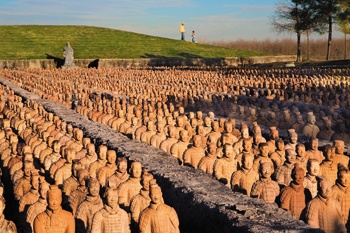You have to love a tour guide who, though you’re sure he’s given the same spiel fifty thousand times, is unwavering in his enthusiasm when it’s your turn to check out what he’s talking about. And so it was, on a blustery day on the prairies of Katy, a young guide name Josh did not come anywhere close to disappointing his small group of curious charges—a half-dozen Scots and a couple of Americans wanting to find out just what Forbidden Gardens is all about.
Protected from the chill wind by a hand-knit muffler and a red hoodie beneath his official shirt, Josh began to unravel the double mystery of this curious tourist attraction that covers nearly 70 acres just off Interstate Highway 10 on the outskirts of Houston. Walking gracefully backward along the stone wall of a pit filled with clay figures of ancient Chinese warriors, our young leader explained that in the third century BCE China was not a unified country until a great fighter named Qin Shi Huang came along, drove out the ruling Mongols, and formed a country over which he appointed himself the first emperor.
The emperor killed a lot of people in his day—1 in 5 of his fellow citizens—for a grand total of over a million and a half served up dead. Fearing the souls of these folks would unite and take him down in heaven, he devised a strategy to protect himself in the afterlife. He decided to bury thousands of soldiers alive so that they could travel with him to the great beyond and cover his back once they got there.
But then, rethinking this plan, Qin realized that killing his best warriors would leave no one on earth to defend his dynasty. Thus, Plan B came to pass: He would create an army of life-sized clay soldiers, no two alike, and bury these warriors at his tomb along with some clay horses and plenty of real weapons. The clay soldiers were left hollow, the theory being that souls could then inhabit the figures and bring them to life at the necessary moment.
In 1974, some Chinese farmers were digging a well near Xi’an when they accidentally discovered some of these faux fighters. To this day, the soldiers are still being excavated, in pieces and, unlike Humpty Dumpty, all these king’s horses and all of his men are being put back together again.
Enter Ira Poon, a wealthy Hong Kong businessman who now lives in Seattle. He wanted to share this slice of Chinese history with the West. After ruling out popular tourist areas in New York, Florida and California as possible locations—even the deep-pocketed have limits on what they’ll pay for real estate—Poon decided Katy would be the perfect place to re-create a miniature version of the emperor’s palace, known as the Forbidden City in Beijing, as well as a copy of Qin’s tomb and the pits of protectors. To the reported tune of $20 million, Forbidden Gardens was built in 1997.
The pit Josh walks along is one of three packed with line after line of soldiers, some a full 6 feet tall, most done in one-third scale. At the back is a knoll representing the emperor’s tomb, and in front of this knoll sits a statue of the man himself. The pits cover an area the equivalent of three football fields, with soldiers facing forward and back, just as they would have in real life to fend off both frontline attacks as well as ambushes from behind. Interestingly, Qin did not put his very best fighters in front. Instead he used the less dedicated conscripts, behind which stood the fiercest fighters. The strategy was that the opposing armies’ best fighters would grow weary killing Qin’s weakest lines and then themselves be killed by Qin’s best, waiting patiently for this pleasure.
In addition to the main pit, which is most breathtaking for the sheer quantity of fighters it contains, two smaller pits hold plenty of interest as well. The smallest of the three contains only 68 figures—commanders at their post, surrounded by bodyguards. The other pit is filled with black- and gray-colored soldiers to represent a fire that was set in the actual pit in China during a raid in which the real weapons buried with the figures were stolen. The thieves set the place ablaze but, lacking forethought, shut the doors behind them when they left, extinguishing the fire and merely charring the figures.
Josh is a nonstop font of information, effortlessly spilling forth countless facts about the empire, which lasted for 500 years. Leading the group to another area, he reveals a pavilion where, under a massive sloping roof, a miniature replica of the Forbidden City stretches across 40,000 square feet (the real deal covered 7.8 million square feet).
From the entrance wall featuring five doorways (the center one was only ever used by the emperor except on his wedding day, when the empress, too, was allowed to use it) to the far-off Imperial Garden in the back, there are buildings great and small displaying how life was for the man, his family and their 10,000 servants. Peopled with tiny figurines, the little city appears vibrant, and you can almost imagine that if a prairie wind blew in hard enough, it would breathe life into the figures and they would scurry about.
Call (281) 347-8000 or visit www.forbidden-gardens.com for more information.
Essayist Spike Gillespie lives in Austin.


